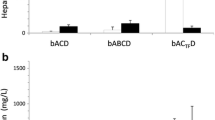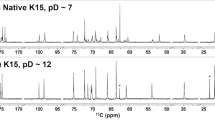Abstract
Heparosan, the capsular polysaccharide of Escherichia coli K5 having a carbohydrate backbone similar to that of heparin, has become a potential precursor for bioengineering heparin. In the heparosan biosynthesis pathway, the gene waaR encoding α-1-, 2-glycosyltransferase catalyzes the third glucosyl residues linking to the oligosaccharide chain. In the present study, a waaR deletion mutant of E. coli K5 was constructed. The mutant showed improvement of capsule polysaccharide yield. It is interesting that the heparosan molecular weight of the mutant is reduced and may become more suitable as a precursor for the production of low molecular weight heparin derived from the wild-type K5 capsular polysaccharide.







Similar content being viewed by others
References
Amor K, Heinrichs DE, Frirdich E, Ziebell K, Johnson RP, Whitfield C (2000) Distribution of core oligosaccharide types in lipopolysaccharides from Escherichia coli. Infect Immun 68(3):1116–1124
Bhaskar U, Sterner E, Hickey AM, Onishi A, Zhang F, Dordick JS, Linhardt RJ (2012) Engineering of routes to heparin and related polysaccharides. Appl Microbiol Biotechnol 93(1):1–16
Bauer KA, Hawkins DW, Peters PC, Petitou M, Herbert JM, van Boeckel CAA, Meuleman DG (2002) Fondaparinux, a synthetic pentasaccharide: the first in a new class of antithrombotic agents–the selective factor Xa inhibitors. Cardiovasc Drug Rev 20(1):37–52
Bitter T, Muir HM (1962) A modified uronic acid carbazole reaction. Anal Biochem 4(4):330–334
Brown S, Kuberan B (2015) Production of size-defined heparosan, heparan sulfate, and heparin oligosaccharides by enzymatic depolymerization. Methods Mol Biol 1229:21–29
Chen JH, Avci FY, Munoz EM, McDowell LM, Chen M, Pedersen LC, Zhang LJ, Linhardt RJ, Liu J (2005) Enzymatic redesigning of biologically active heparin sulfate. J Biol Chem 280(52):42817–42825
Cress BF, Englaender JA, He W, Kasper D, Linhardt RJ, Koffas MAG (2014) Masquerading microbial pathogens: capsular polysaccharides mimic the host-tissue molecules. FEMS Microbiol Rev 38:660–697
Cress BF, Toparlak ÖD, Guleria S, Lebovich M, Stieglitz JT, Englaender JA, Jones JA, Linhardt RJ, Koffas MAG (2015) CRISPathBrick: modular combinatorial assembly of type II-A CRISPR arrays for dCas9-mediated multiplex transcriptional repression in E. coli. ACS Synth Biol 4(9):987–1000
DeAngelis PL, Gunay NS, Toida T, Mao WJ, Linhardt RJ (2002) Identification of the capsular polysaccharides of type D and F Pasteurell amultocida as unmodified heparin and chondroitin, respectively. Carbohydr Res 337:1547–1552
Frirdich E, Lindner B, Holst O, Whitifield C (2003) Overexpression of the waaZ gene leads to modification of the structure of the inner core region of Escherichia coli lipopolysaccharide, truncation of the outer core, and reduction of the amount of O polysaccharide on the cell surface. J Bacteriol 185(5):1659–1671
He WQ, Fu L, Li G, Jones JA, Linhardt RJ, Koffas M (2015) Production of chondroitin in metabolically engineered E. coli. Metab Eng 27:92–100
Heinrichs DE, Yethon JA, Whitfield C (1998) Molecular basis for structural diversity in the core regions of the lipopolysaccharides of Escherichia coli and Salmonella enterica. Mol Microbiol 30(2):221–232
Higashi K, Hosoyama S, Ohno A, Masuko S, Yang B, Sterner E, Wang ZY, Linhardt RJ, Toida T (2012) Photochemical preparation of a novel low molecular weight heparin. Carbohydr Polym 87(2):1737–1743
Higashi K, Ly M, Wang ZY, Masuko S, Bhaskar U, Sterner E, Zhang FM, Toida T, Dordick JS, Linhardt RJ (2011) Controlled photochemical depolymerization of K5 heparosan, a bioengineered heparin precursor. Carbohydr Polym 86(3):1365–1370
Huang HC, Zhao YY, Lv SC, Zhong WH, Zhang FM, Linhardt RJ (2014) Quantitation of heparosan with heparin lyase III and spectrophotometry. Anal Biochem 447:46–48
Huang HC, Li XL, Li N, Zhong WH (2013a) Effect of enviromental stresses on heparosan biosynthesis by Escherichia coli K5. J Pure Appl Microbiol 7(4):3025–3029
Huang HC, Lv SC, Zhao L, Yan ZQ, Zhong WH, Zhang FM (2013b) Capsule treatment by soluble expressed recombinant heparinase II enhance the foreign gene transformation to Escherichia coli K5. J Pure Appl Microbiol 7(4):3009–3015
Linhardt RJ (2003) 2003 Claude S. Hudson Award address in carbohydrate chemistry. Heparin: structure and activity. J Med Chem 46(13):2551–2554
Linhardt RJ, Gunay NS (1999) Production and chemical processing of low molecular weight heparins. Sem Thromb Hemostas 25(3):5–16
Linhardt RJ, Liu J (2012) Synthetic heparin. Curr Opin Pharmacol 12(2):217–219
Li PL, Sheng JZ, Liu YH, Li J, Liu J, Wang FS (2013) Heparosan-derived heparan sulfate/heparin-like compounds: one kind of potential therapeutic agents. Medicinal Res Rev 33(3):665–692
Lohse DL, Linhardt RJ (1992) Purification and characterization of heparin lyases from Flavobacterium heparinum. J Biol Chem 267(34):24347–24355
Petitou M, van Boeckel CAA (2004) A synthetic antithrombin III binding pentasaccharide is now a drug! What comes next? Angew Chemie-Int Ed 43(24):3118–3133
Raetz CRH, Whitfield C (2002) Lipopolysaccharide endotoxins. Ann Rev Biochem 71:635–700
Suflita M, Fu L, He W, Koffas M, Linhardt RJ (2015) Heparin and related polysaccharides: synthesis using recombinant enzymes and metabolic engineering. Appl Microbiol Biotechnol 99:7465–7479
Su GW, Li LH, Huang HC, Zhong WH, Yu P, Zhang FM, Linhardt RJ (2015) Production of a low molecular weight heparin production using recombinant glycuronidase. Carbohydr Polym 134:151–157
Taylor CM, Goldrick M, Lord L, Roberts IS (2006) Mutations in the waaR gene of Escherichia coli which disrupt lipopolysaccharide outer core biosynthesis affect cell surface retention of group 2 capsular polysaccharides. J Bacteriol 188(3):1165–1168
Wang Z, Ly M, Zhang F, Zhong W, Suen A, Hickey AM, Dordick JS, Linhardt RJ (2010) E. coli K5 fermentation and the preparation of heparosan, a bioengineered heparin precursor. Biotechnol Bioengineer 107(6):964–973
Wang ZY, Dordick JS, Linhardt RJ (2011a) Escherichia coli K5 heparosan fermentation and improvement by genetic engineering. Bioengineer Bugs 2(1):63–67
Wang ZY, Yang B, Zhang ZQ, Ly M, Takieddin M, Mousa S, Liu J, Dordick JS, Linhardt RJ (2011b) Control of the heparosan N-deacetylation leads to an improved bioengineered heparin. Appl Microbiol Biotechnol 91(1):91–99
Whitfield C, Roberts IS (1999) Structure, assembly and regulation of expression of capsules in Escherichia coli. Mol Microbiol 31(5):1307–1319
Wu JJ, Zhang C, Mei X, Li Y, Xing XH (2014) Controllable production of low molecular weight heparins by combinations of heparinase I/II/III. Carbohydr Polym 101:484–492
Zhang ZQ, McCallum SA, Xie J, Nieto L, Corzana F, Jimenez-Barbero J, Chen M, Liu J, Linhardt RJ (2008) Solution structures of chemoenzymatically synthesized heparin and its precursors. J Am Chem Soc 130(39):12998–13007
Acknowledgments
This study was funded by the Natural Science Foundation of China (Grant No. 21076195), the Science Technology Department of Zhejiang Province (Grant No. 2011C24007), the Specialized Research Fund for the Doctoral Program of Higher Education (Grant No. 20113317110002), and the Open Research Fund of Zhejiang Province Top Key Discipline of Biological Engineering (2015).
Author information
Authors and Affiliations
Corresponding author
Ethics declarations
Conflict of interest
The authors declare that they have no conflicts of interest.
Ethical approval
This article does not contain any studies with human participants or animals performed by any of the authors.
Informed consent
Informed consent was obtained from all individual participants included in the study.
Electronic supplementary materials
ESM 1
(PDF 274 kb)
Rights and permissions
About this article
Cite this article
Huang, H., Liu, X., Lv, S. et al. Recombinant Escherichia coli K5 strain with the deletion of waaR gene decreases the molecular weight of the heparosan capsular polysaccharide. Appl Microbiol Biotechnol 100, 7877–7885 (2016). https://doi.org/10.1007/s00253-016-7511-y
Received:
Revised:
Accepted:
Published:
Issue Date:
DOI: https://doi.org/10.1007/s00253-016-7511-y




